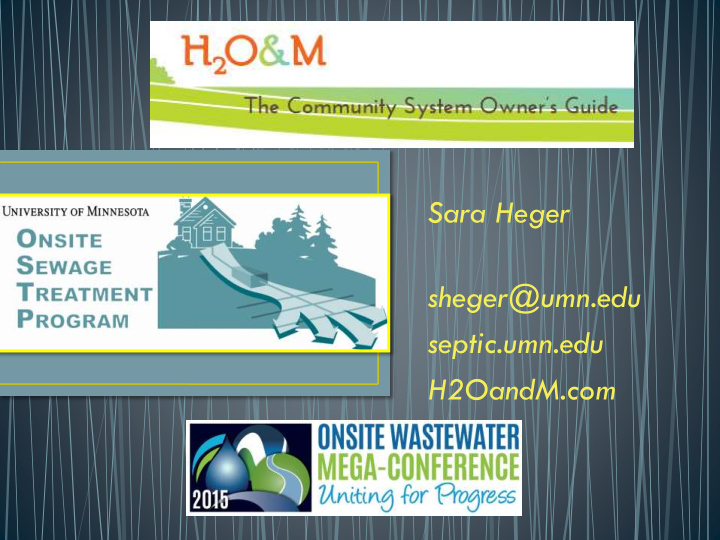



Sara Heger sheger@umn.edu septic.umn.edu H2OandM.com
• Program began in 1974 • Professional Training – Septic System: Designers, Inspectors, Pumpers, Installers • Research and Demonstration • Homeowner Operation & Maintenance • Small Community Wastewater Solutions • Housed within the Water Resources Center
• Why this project? • Project objectives • Tool • Using the tool • Next steps and timeline
• Funding: National Institute of Food and Agriculture (NIFA) grant • Lead institution: University of Minnesota, Sara Heger (PI) and Dave Gustafson • Project development team • Iowa Department of National Resources, Dan Olson • North Carolina Onsite Water Protection Section, Nancy Deal • Southeast Wastewater Initiative, Aaron Wills & Sheila Craig • University of Arizona, Kitt Farrell-Poe • Wastewater Education, Dendra Best • Tool/database support • The Carney Group, Jules Inda and Pat Carney
• Management is critical • Increase in cluster systems and advanced treatment systems with more critical management activities • Need for customized information
• There wasn’t one! • Allow for local variation • Everything is going • Ease in updating in electronic the future • Allow for national • National clearing perspective on management house
• 25% of the US population • 70 million Americans • 5 billion gallons per day • ~33% of all new construction • Unquantified number of commercial properties • strip malls, resorts, restaurants, gas stations and similar • US EPA estimates that there are more than 350,000 existing large-capacity septic systems (serving more than 20 people) nationwide
• Lack of space for individual system replacement • Reduction of load allocation for meeting total maximum daily load standards • Reduced costs compared to wastewater treatment plants • Smart growth initiatives • Development and redevelopment occurring outside the reach of municipal sewer extensions
• Bridge the gap between septic system professionals, regulators, and owners • Produce sound management guidance from the perspective of a system owner • Raise the bar for management expectations • Educate system owners to clearly define long term maintenance activities • Increased system performance • Long-term cost-savings
• Develop content and a web interface to produce an expert-driven and locally-customized manual for any soil-based wastewater treatment system (does include surface discharge, but not wastewater treatment plants) • Provide owners and users with fundamental information about the operation and management of their systems • Electronic or hard-copy • Can be updated if the system, user or other details change
• H2OandM.com is an online tool to create customized homeowner O&M manuals for onsite septic systems from a single family home to a large cluster system • The tool will work for newly designed/installed systems or those that have been in the ground a long time
• Boilerplate sections written by team • Allows the input of local information • Number of connections, treatment train components, local permitting issues, rate structures • Any regional, state, or local differences in regulations that affect the management of community systems. • Only need to be entered once to minimize development time for each O&M Guide
• Online tool: • Developer • Engineers/Designers • Installers, Operators, Service Providers • Regulators, • Facilitators, and • Informed community members • H2OandM guide • Individual owner of a septic system • Homeowner part of cluster system
• The specific treatment train components and how they work, in addition to the service activities and frequencies • Text • Diagrams and pictures • The management issues, challenges, and operations plan each system has identified and implemented to ensure long-term, effective wastewater treatment • The operational responsibilities each system user must accept to protect the infrastructure from preliminary failure
• Each H2O&M guide will be a combination of: • Boilerplate content and imagery that has been critically reviewed by project development team • Locally customized content and images • What if user of tool doesn’t know key info? • Tool will send user to other resources
• A septic system professional creates an account where all their projects are stored • Using the web interface they enter specific site and system information • Tool creates an electronic or hard copy O&M manual which includes • stock image and text • customized information entered
• In-home plumbing – type, access and O&M • Collection – type, access and O&M • Tanks – type, access and O&M • Advanced treatment systems - type, access and O&M • Final treatment and dispersal – type, access and O&M • General use and operation • Specific O&M and options for extending life • Problems/Troubleshooting
• Value added information to customer • Professional/third party recommendations on O&M activities and home management tips • Ability to update the O&M manuals as the system or user changes • Capability to create templates for commonly designed, installed or serviced systems
• Tool available at H2OandM.com • Training will be conducted in 2016 at conferences and via webcast • Interested in training opportunities, questions or feedback: • Sara Heger an email – sheger@umn.edu
This project was supported by the National Integrated Water Quality Grant Program no. 2012-51130-20185 from the USDA National Institute of Food and Agriculture.
septic.umn.edu H2OandM.com sheger@umn.edu
Recommend
More recommend